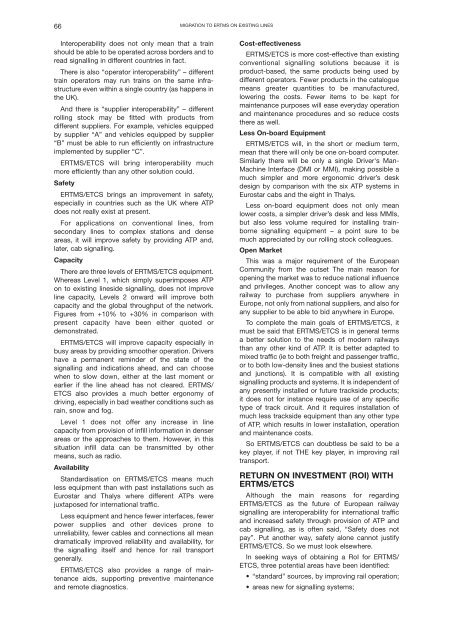Proceedings 2002/2003 - IRSE
Proceedings 2002/2003 - IRSE
Proceedings 2002/2003 - IRSE
You also want an ePaper? Increase the reach of your titles
YUMPU automatically turns print PDFs into web optimized ePapers that Google loves.
66 MIGRATION TO ERTMS ON EXISTING LINES<br />
Interoperability does not only mean that a train<br />
should be able to be operated across borders and to<br />
read signalling in different countries in fact.<br />
There is also “operator interoperability” – different<br />
train operators may run trains on the same infrastructure<br />
even within a single country (as happens in<br />
the UK).<br />
And there is “supplier interoperability” – different<br />
rolling stock may be fitted with products from<br />
different suppliers. For example, vehicles equipped<br />
by supplier “A” and vehicles equipped by supplier<br />
“B” must be able to run efficiently on infrastructure<br />
implemented by supplier “C”.<br />
ERTMS/ETCS will bring interoperability much<br />
more efficiently than any other solution could.<br />
Safety<br />
ERTMS/ETCS brings an improvement in safety,<br />
especially in countries such as the UK where ATP<br />
does not really exist at present.<br />
For applications on conventional lines, from<br />
secondary lines to complex stations and dense<br />
areas, it will improve safety by providing ATP and,<br />
later, cab signalling.<br />
Capacity<br />
There are three levels of ERTMS/ETCS equipment.<br />
Whereas Level 1, which simply superimposes ATP<br />
on to existing lineside signalling, does not improve<br />
line capacity, Levels 2 onward will improve both<br />
capacity and the global throughput of the network.<br />
Figures from +10% to +30% in comparison with<br />
present capacity have been either quoted or<br />
demonstrated.<br />
ERTMS/ETCS will improve capacity especially in<br />
busy areas by providing smoother operation. Drivers<br />
have a permanent reminder of the state of the<br />
signalling and indications ahead, and can choose<br />
when to slow down, either at the last moment or<br />
earlier if the line ahead has not cleared. ERTMS/<br />
ETCS also provides a much better ergonomy of<br />
driving, especially in bad weather conditions such as<br />
rain, snow and fog.<br />
Level 1 does not offer any increase in line<br />
capacity from provision of infill information in denser<br />
areas or the approaches to them. However, in this<br />
situation infill data can be transmitted by other<br />
means, such as radio.<br />
Availability<br />
Standardisation on ERTMS/ETCS means much<br />
less equipment than with past installations such as<br />
Eurostar and Thalys where different ATPs were<br />
juxtaposed for international traffic.<br />
Less equipment and hence fewer interfaces, fewer<br />
power supplies and other devices prone to<br />
unreliability, fewer cables and connections all mean<br />
dramatically improved reliability and availability, for<br />
the signalling itself and hence for rail transport<br />
generally.<br />
ERTMS/ETCS also provides a range of maintenance<br />
aids, supporting preventive maintenance<br />
and remote diagnostics.<br />
Cost-effectiveness<br />
ERTMS/ETCS is more cost-effective than existing<br />
conventional signalling solutions because it is<br />
product-based, the same products being used by<br />
different operators. Fewer products in the catalogue<br />
means greater quantities to be manufactured,<br />
lowering the costs. Fewer items to be kept for<br />
maintenance purposes will ease everyday operation<br />
and maintenance procedures and so reduce costs<br />
there as well.<br />
Less On-board Equipment<br />
ERTMS/ETCS will, in the short or medium term,<br />
mean that there will only be one on-board computer.<br />
Similarly there will be only a single Driver's Man-<br />
Machine Interface (DMI or MMI), making possible a<br />
much simpler and more ergonomic driver’s desk<br />
design by comparison with the six ATP systems in<br />
Eurostar cabs and the eight in Thalys.<br />
Less on-board equipment does not only mean<br />
lower costs, a simpler driver’s desk and less MMIs,<br />
but also less volume required for installing trainborne<br />
signalling equipment – a point sure to be<br />
much appreciated by our rolling stock colleagues.<br />
Open Market<br />
This was a major requirement of the European<br />
Community from the outset The main reason for<br />
opening the market was to reduce national influence<br />
and privileges. Another concept was to allow any<br />
railway to purchase from suppliers anywhere in<br />
Europe, not only from national suppliers, and also for<br />
any supplier to be able to bid anywhere in Europe.<br />
To complete the main goals of ERTMS/ETCS, it<br />
must be said that ERTMS/ETCS is in general terms<br />
a better solution to the needs of modern railways<br />
than any other kind of ATP. It is better adapted to<br />
mixed traffic (ie to both freight and passenger traffic,<br />
or to both low-density lines and the busiest stations<br />
and junctions). It is compatible with all existing<br />
signalling products and systems. It is independent of<br />
any presently installed or future trackside products;<br />
it does not for instance require use of any specific<br />
type of track circuit. And it requires installation of<br />
much less trackside equipment than any other type<br />
of ATP, which results in lower installation, operation<br />
and maintenance costs.<br />
So ERTMS/ETCS can doubtless be said to be a<br />
key player, if not THE key player, in improving rail<br />
transport.<br />
RETURN ON INVESTMENT (ROI) WITH<br />
ERTMS/ETCS<br />
Although the main reasons for regarding<br />
ERTMS/ETCS as the future of European railway<br />
signalling are interoperability for international traffic<br />
and increased safety through provision of ATP and<br />
cab signalling, as is often said, “Safety does not<br />
pay”. Put another way, safety alone cannot justify<br />
ERTMS/ETCS. So we must look elsewhere.<br />
In seeking ways of obtaining a RoI for ERTMS/<br />
ETCS, three potential areas have been identified:<br />
• “standard” sources, by improving rail operation;<br />
• areas new for signalling systems;

















